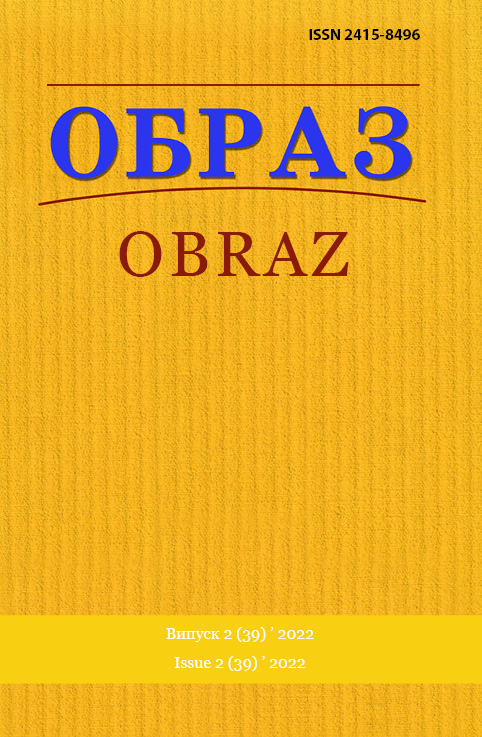Abstract
Introduction. The importance of the textual component of a media message is based on the possibility of using psychological methods of influencing the audience, adding author’s emotions and the social significance of the message. This became especially important during the war. In the social sphere, media texts have always carried messages designed to reveal the most painful topics for society, but during the war, media messages in the commercial sphere began to associate their texts more often with social issues.
Relevance and purpose. The purpose of our study is to determine the socio-psychological characteristics of the texts of media messages. The relevance is due to the need to find out the most important characteristics of modern media messages in social networks and compare media texts in the social and commercial spheres.
Methodology. The main method used in the article is content analysis. The descriptive method allowed selecting units of analysis and classifying them for analysis. The systematic approach that allowed us to identify trends concerning the peculiarities of the content texts of media messages.
Results. As a result of our study, the features of messages in the social network «Facebook» were clarified based on the content analysis of 157 texts in the social and commercial spheres. This made it possible to find out the most important characteristics of modern media messages, in particular the volume of texts, days of publication and the relationship between messages, the use of the first sentence of the message as a means of attracting the attention of the audience, the use of numbers, hyperlinks, and visual integrations in media texts. It was found that a common way is to use an exclamatory or interrogative sentence as the first phrase, when there is a certain statement with an exclamation point at the end, questions to the target audience, etc. Also, the socio-psychological features of the texts of media messages were clarified the informal style of texts, the use of diminutive words in messages, the use of geographical specification, the use of storytelling technology, saturation of the text with emotions, etc. The study identified the messages that attracted the most attention of the audience and carried out a structural analysis of media texts, which made it possible to identify the components of the AIDMA communication model in the structure of messages in social networks. It should be noted that despite the significant difference in the topics of messages in the commercial and social spheres, the structure of media texts is largely similar.
Conclusions. As a result of our study, we have clarified the main socio-psychological features of modern media messages, which made it possible to compare the main characteristics of media texts in the social and commercial fields. Accordingly, the novelty and practical value of the results obtained are important for identifying the factors influencing messages in social networks on the target audience.
References
1. Bohdan, V. (2020), «The title of a media text as the main means of pragmatic influence on the reader», Proceedings of XIII All-Ukrainian Conference «Nauka. Osvita. Molod», Uman, 22 April 2020, Vizavi, Uman, pp. 15–17.
2. Kuznyetsova, T.V. (2022), «Sociocultural determinants of evaluative perception of media text», Vcheni zapysky TNU imeni V. I. Vernadskoho. Seriya: Filolohiya. Zhurnalistyka [Scholarly Notes of TNU Named after VI Vernadskyi. Series: Philology. Journalism], vol. 33 (72), no. 1 (3), pp. 143–148.
3. Plyusch, O.M. (2018), Social-psychological Mechanisms of Information Influence in Postindustrial Society, PhD diss. (psychology sciences), Institute of Social and Political Psychology of the National Academy of Sciences of Ukraine, 400 p.
4. Chetverikova, O. (2020), «Advertising media text as a reflection of English-language national and cultural markers», Text et culture : zbirnyk naukovykh prats, RVV IDHU, Izmail, vol. 5, pp. 69–73.
5. Shulska, N.M., Zinchuk, R.S. (2021), «Communicative and functional potential of headlines in the language of modern media», Vcheni zapysky TNU imeni V. I. Vernadskoho. Seriya: Filolohiya. Zhurnalistyka [Scholarly notes of TNU Named after VI Vernadskyi. Series: Philology. Journalism], vol. 32 (71), no. 5 (2), pp. 220–225.
6. Shchepka, O.A. (2018), «Modern journalistic text: qualifying and differential features», Naukovyy visnyk Mizhnarodnoho humanitarnoho universytetu. Seriya: Filolohiya [Scientific Bulletin of the International Humanitarian University. Series: Philology], vol. 2, no. 34, pp. 103–106.
7. Berger J., Humphreys A., Ludwig S., Moe W. W., Netzer O., Schweidel D. A. Uniting the tribes: Using text for marketing insight. Journal of Marketing. 2020. Vol. 84, Iss. 1. P. 3–25.
8. Davlatovna T. K. Media text as a component of mass communication. Asian Journal of Research in Social Sciences and Humanities. 2022. Vol. 12, Iss. 4. P. 218–224.
9. Guan Z., Li B., Hou F., Chong A., Thatcher J. B. A Text-Analytic Approach to Deciphering the Roles of Users in Contributing to Collective Storytelling in Social Media. Pacific Asia Conference on Information Systems: Proceedings of the International Conference (2022 July 5–9). Sydney, 2022. P. 288–305.
10. Mirzajonov A. K. The importance of discourse and media text in modern media. Academicia: an International Multidisciplinary Research Journal. 2021. Vol. 11, Iss. 2. P. 24–26.
11. Shpak M., Kichuk A., Sytnyk O., Ishchuk N., Filonenko D., Hrozna O. Socio-Psychological Factors of User Trust in Information in Electronic Mass Communication. Studies of Applied Economics. 2021. Vol. 39, Iss. 5. P. 3–12.
12. Zhao Z., Zhu H., Xue Z., Liu Z., Tian J., Chua M., Liu M. An image-text consistency driven multimodal sentiment analysis approach for social media. Information Processing & Management. 2019. Vol. 56, Iss. 6. P. 97–102.

This work is licensed under a Creative Commons Attribution 4.0 International License.

